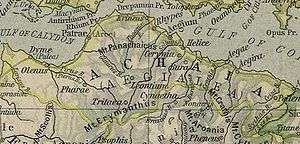Battle of Dyme
| Battle of Dyme | |||||||
|---|---|---|---|---|---|---|---|
| Part of Cleomenean War | |||||||
 A map of Achaea showing Dyme on the left. | |||||||
| |||||||
| Belligerents | |||||||
| Sparta | Achaean League | ||||||
| Commanders and leaders | |||||||
| Cleomenes III |
Hyperbatas, Aratus | ||||||
| Casualties and losses | |||||||
| Low | Heavy | ||||||
The Battle of Dyme or Dymae was a battle that was fought by the Achaean League under the command of their Strategos, Hyperbatas and a Spartan army under the command of King Cleomenes III and was part of the Cleomenean War. The battle took in place near Dyme in north-west Achaea and was fought in 226 BC.
Prelude
Following the declaration of war against Sparta by the Achaean League in around 229 BC-228 BC,[1] the fighting between the two countries had almost been continuous. Cleomenes had crushed two Achaean armies under the command of Aratus of Sicyon at the Battle of Mount Lycaeum and at the Battle of Ladoceia in 227 BC.[2]
After these victories, Cleomenes returned to Sparta and began radical reforms. He abolished the ephors,[3][4] changed land laws, cancelled debt and he also changed his army into one of the Macedonian style.[4][5] Following these reforms, Cleomenes with his reformed army answered to appeals from the city of Mantinea and after ridding it of its Achaean garrison advanced north into the Achaean heartland.[6]
Battle
After advancing into Achaea, Cleomenes descended upon Pharae, a founding member of the league. His aim was to provoke a battle with the Achaeans or if they didn't come to meet him in battle, to discredit Aratus. The strategus at the time was, Hyperbatas, however Aratus had complete control of the League.[6]
As Cleomenes was besieging the city of Dyme, the full Achean army came out to meet him. When Cleomenes saw them pitch camp, deciding not to battle the enemy while his rear was exposed to attacks from the garrison of Dyme, he advanced on the Achean position.[6] In the pitched battle that followed, the Spartan phalanx routed the Achaean phalanx with the Achaeans sustaining heavy casualties and with many of the survivors being captured.[6]
Aftermath
This defeat crushed the Achaeans and forced them to sue for peace. Cleomenes offered to give back any cities he seized from the Achaeans and to return any prisoners he had taken in return for being made strategus of the Achaean League. It may be however how Plutarch states that the Achaeans, after seeing his many victories wished for Cleomenes to command them.[7][8] However, Aratus who was against this proposal sent ambassadors to the court of King Antigonus III Doson where he requested Antigonus' aid against the Spartans which he received in return for giving Acrocorinth to Macedon.[9]
In 224 BC, Antigonus advanced into the Peloponnese with an army of 30,000 men and forced Cleomenes to retreat to Laconia, the Spartan heartland.[10] In 222 BC, the Macedonian-Achaean army and the Spartan army clashed at the Battle of Sellasia which ended in an allied victory.[11] This victory forced Cleomenes to flee from Greece and go to Egypt.[11][12][13] While Antigonus took Sparta, making him the first foreigner to ever capture Sparta.[13]
Notes
- ↑ Polybius 2.46
- ↑ Polybius 2.51
- ↑ Plutarch, Life of Cleomenes, 8
- 1 2 Green, Alexander to Actium: The Historical Evolution of the Hellenistic Age, 257
- ↑ Plutarch, Life of Cleomenes, 11
- 1 2 3 4 Plutarch, Life of Cleomenes, 14
- ↑ Plutarch, Life of Cleomenes, 15
- ↑ Green, Alexander to Actium: The Historical Evolution of the Hellenistic Age, 258
- ↑ Plutarch, Life of Cleomenes, 16
- ↑ Plutarch, Life of Cleomenes, 22
- 1 2 Polybius 2.69
- ↑ Plutarch, Life of Cleomenes, 29
- 1 2 Green, Alexander to Actium: The Historical Evolution of the Hellenistic Age, 261
References
Primary sources
- Plutarch, translated by Richard Talbert, (1988). Life of Cleomenes. New York: Penguin Classics. ISBN 0-14-044463-7.
- Polybius, translated by Frank W. Walbank, (1979). The Rise of the Roman Empire. New York: Penguin Classics. ISBN 0-14-044362-2.
Secondary sources
- Peter Green, (1990). Alexander to Actium: The Historical Evolution of the Hellenistic Age. Los Angeles: University of California Press. ISBN 0-500-01485-X.